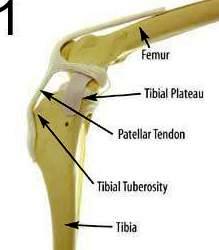So what is the simplest explanation of how TTA works?
During the extension of the stifle joint, the patella tendon and quadriceps muscle pull in a cranial direction of the tibia. As the knee joints move from extension to flexion, the direction of the pull of the quadriceps muscle changes direction, pulling caudally as the angle of the stifle joint approaches 90°. By advancing the tibial tuberosity cranially to the point where the patellar tendon and tibial plateau are perpendicular to each other standing angle of the canine stifle, the quadriceps can only pull the tibia caudally, eliminating cranial thrust and converting it to a caudal thrust. Along with a model of the TTA, this is how I usually explain the process to a client.
What are the advantages of TTA over TPLO?
- Surgically, TTA is less invasive than a TPLO. The osteotomy is not nearly as aggressive, and the surgical dissection is less, as there is no need to elevate the cranial tibialis or popliteus muscles.
- TTA extends the lever arm of the stifle joint resulting in a knee that can be more easily extended; TPLO shortens the lever arm.
- TTA does not change the geometry of the joint or result in angular change; TPLO causes a slight varus from placing the joint into 20° of flexion permanently.
- TPLO causes a cranial shifting of the femur relative to the tibia resulting in increased pressures within the join; TTA increases the joint surface area to redistribute the pressure within the joint to a lower value.
- TTA decreases retropatellar forces, and hence chondromalacia; there is no patellar tendonitis postoperatively.

Normal Joint
The normal joint, viewed from the side, shows the upper bone, the femur and the lower bone, the tibia. The Tibial Plateau is the actual point of contact between the femur and the tibia. In this diagram, the Patellar Tendon is clearly visible. It is this structure that must offset the abnormal forces that are created with a rupture of the cranial cruciate ligament.

Typical Joint Angle
In the typical joint, the angle formed between the Tibial Plateau and the Patellar Tendon is about 115 degrees when the leg is in a normal standing position.

Corrected Angle
The abnormal motion that occurs in a knee with a torn cruciate ligament is called Tibial Thrust. After the TTA Surgery, the corrected angle is now 90 degrees, which will offset the forces in the knee that tend to make it unstable.

Surgical Appearance
This diagram shows the knee once it has been stabilized with the appropriate Titanium implants. These implants are very lightweight and are designed to stay in permanently.
We put your pet first.
Interesting in learning more about how we can help your pet? Check out more services by clicking the button below, or call us directly.

High-quality veterinary care in Chesterfield County.
We are an established, second-generation, full-service, small animal veterinary facility that has been serving and caring for the pets of Chesterfield County, Virginia since 1968.
Book An Appointment
Give us a call at 804-748-2244 to book an appointment.
Contact Us
Address
12021 Ironbridge Road
Chester, Virginia 23831
Call or Text Us
Email Us
Fax Us
804-748-7260
Hours
Mon – Fri: 8:00AM – 6:00PM
Sat: 8:00AM – 12:00PM
Sun: Closed
Send a message.
We'll get back to you as quickly as possible!

